Tags
dVerse poetics, Glenn A. Buttkus, Minimalism, Minimalist Photography, Sanaa Rizvi, the muse as excuse, Writing through life
Hello dVerse Poets!
Sanaa here (aka adashofsunny) to stir your muses. The days are leading us to summer, when the leaves are dark green and full, open toward the sun and breathing in the warm, aromatic air.
Minimalist photography draws inspiration from the idea of minimalism in art, which emerged in New York in the early 1960’s.
‘Minimalism,’ is a movement in sculpture and painting which arose in the 1950s, characterized by the use of simple, massive forms. It’s marked by clarity, purpose and intention.
At its core, being a minimalist means intentionally promoting the things we value the most and removing everything that distracts us from it.
That being said, the goal of minimalist photography is to convey a concept, or an idea, to provoke an emotional response or provide a visual experience that is unique.
Picture courtesy: ‘Person holding a camera,’ by Fauxels, Pexels.com
Minimalism is a style employed by many 20th Century artists, using a minimum amount of components such as colour, shape, line and texture. Within the art world it is considered an extremely subjective concept, leaving interpretation and meaning up to the viewers perception of the work.
There are many factors that contribute such as simplicity; the idea is to pick a striking and engaging subject that will catch the eye. The subject, in general, has to be the strongest element of the shot, even though it might not take up majority of the frame.
In addition, achieving a powerful compositional element to a minimalist photograph is key in enhancing the impact. Complimentary colour, the effectiveness of line within a shot can also be vital in adding to the subject matter of the image.
Can you tell a story through a photograph in minimalist style? Is it possible to convey a scene or event using textures, colours and shapes? The answer, is yes!
It gives me great pleasure to honor and to showcase Glenn A. Buttkus’s site “South Sound Minimalist Photos,” this evening. You can find his fabulous site by clicking on the link below:
This is what he has to share about Minimalist Photography and his experience:
“Minimalist Photography” has really blossomed over the last decade. I was snapping minimalist images for several years, simply because the concept intrigued me. You walk up to an old classic car, and right away you begin to dissect the various parts—the grill, bumpers, hood ornament, chrome model words and brands, doors windshield door handles, headlights, tail lights, interior; and on and on, being fascinated with “part of the whole” and less is more. Three years ago I discovered online that Minimalist Photography was an international phenomenon. Dozens, even hundreds, of minimalist sites exist. I immediately started my own Facebook photography site, hoping to get my images out there. Most of the sites use prompts, and they give awards for what they consider are the best ones. Initially I joined 30 of these sites, and slowly became known and accepted. My site, SOUTH SOUND MINIMALIST PHOTOS, has grown to 1,500 members, spanning much of the globe. As many of you have demonstrated with wonderful images of your own to illustrate your poetry, minimalism is an art form, and poetry can spring out of it.
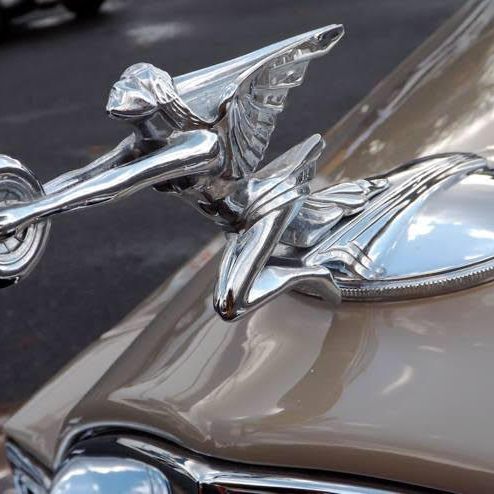
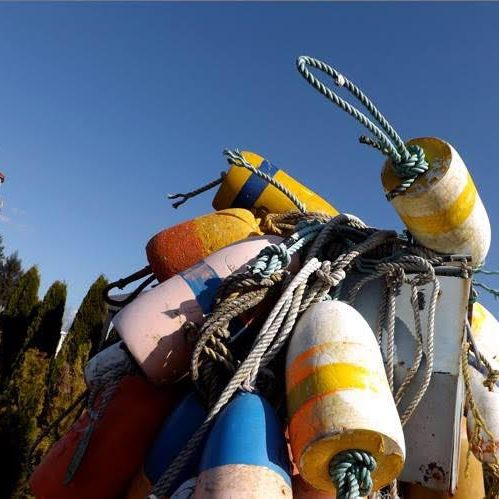

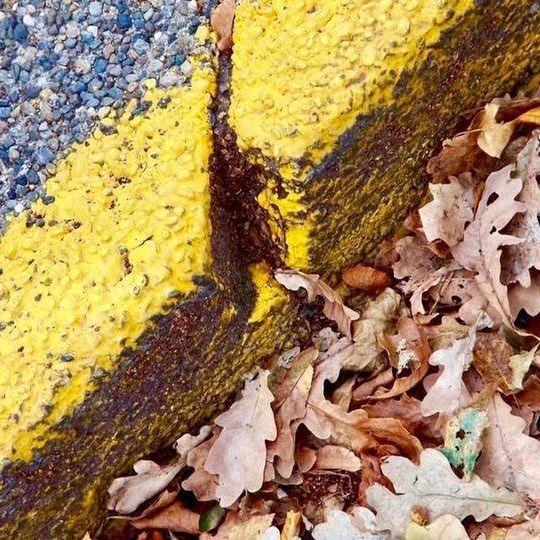

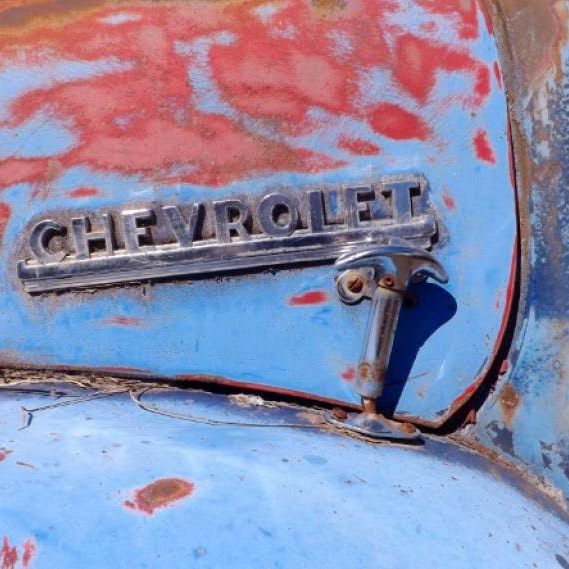

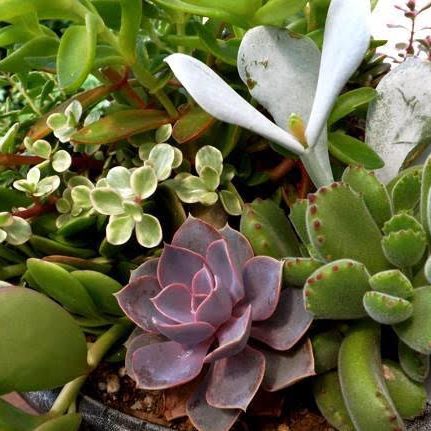
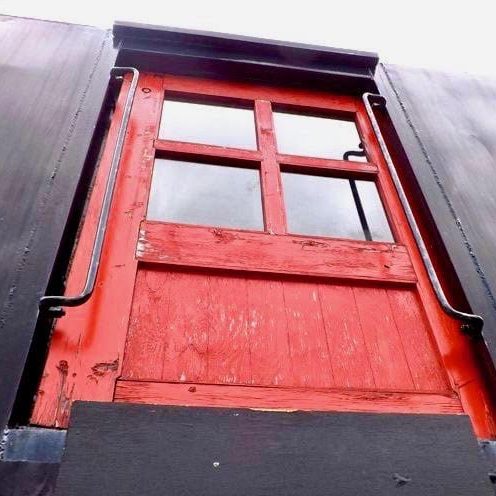



In addition to the photographs, Glenn has also offered us poetic prose as accompaniment, whose beauty took my breath away! If you decide to use it as inspiration, please do remember to give credit.
- The fancy 30’s hood ornament.
“I was created during the Great Depression, and taught to speed on by all the unpleasantness.”
- The fishing net floats:
“Terrible storms tore many of us from our nets, and left us at the stone feet of the peeling Lighthouse.”
- Railroad track crossing concrete.
‘“Raw steel tracks vibrate as they run across concrete at crossings, forming geometric bliss.”
- Leaves and yellow curb.
“Autumn leaf gliders pile up their brittle bodies against blackened curbs, both hug and death throes.”
- Green Tomato Plant:
“Juicy tomatoes thrive in the Northwest, first as green goblins, then as love fruit.”
- Blue Pickup
“The 50’s blue Chevrolet pickup sported both its patina, and its untarnished chrome.”
- Old Rusty Truck
“The isolated Model T truck bears the weight and pride of a hundred years of rust, becoming prairie art and sentinel.”
- Green Succulents:
“We succulents seem so hardy, but actually we have fragile roots, and require gentle repotting.”
- The Red Door:
“The imposing red door towered above me, and it had no handle, opening only from the inside.”
- The Totem Pole:
“Most totem poles are well anchored by the sea, but eons of stormy weather can strip it of its decor.”
- Yellow School Bus
“A school bus must have a plethora of pulsating and reflecting lights, because nothing is more precious than its cargo.”
- Clock Tower:
“From my cage, I could clearly see the clock tower, and at times it made me weep.”
Thank you so much, once again, Glenn for everything. I so love the prose pieces as accompaniment, they truly give us a further glimpse into the intent and emotion behind the photographs.
For today’s Poetics, I want you all to select one out of the twelve photographs shared above and write a poem. It can be an Ekphrastic poem, if you like. Go philosophical. Go dark or romantic or solemn. Share what you feel about Minimalist photography when you see it. The idea here is to provoke an emotion, and what better way to pour them out other than poetry?
New to dVerse? Here’s how to join in:
- Write a poem (in any form) in response to the challenge.
- Enter a link directly to your poem and your name by clicking Mr. Linky below
and remember to check the little box to accept the use/privacy policy. - You will find links to other poets and more will join so please do check
back later in order to read their poems. - Read and comment on other poets’ work– we all come here to have our poems read.
- Please link back to dVerse from your site/blog.


Welcome to Poetics, everyone!
On the menu we have Barbecue ribs and Malbec, Shrimp Scampi with Chardonnay or if you prefer we also have cherry almond sweetheart scones with coffee/tea of your choice.
See you on the Poetry trail! 💝💝
Please, just some fresh mint tea for me tonight… I love the pictures by Glenn, what a good idea to use his photography as the prompt.
Fresh mint tea coming right up! 😀 So good to see you, Bjorn. Yes I am so excited to read all the responses tonight!
Hi Sanaa, that’s a delicious sounding menu! I will have the tea and scones please 🙂 Thank you for an interesting prompt which really pushed my poetic skills!
Cherry almond sweetheart scones with tea coming right up! 😀 Heading over to read you Ingrid 💝💝
Thank you Sanaa 💕
You’re welcome! xx
Hello Sanaa and All. Sanaa I very much enjoyed learning the origin story of minimalist photography. Wonderful idea to have us be inspired by examples of it provided by our very own Glenn Buttkus. Good weather here. Got my mower back at dusk yesterday and have been out there cutting down tall fields. A glass of iced peppermint raspberry tea sounds just right please, Sadje?
A glass of iced peppermint raspberry tea it is! Enjoy 😀 The weather is a bit humid here .. we are awaiting monsoon which will begin in July. Thanks for joining in, Lisa 💝💝
Thank you so much, Sanaa, that really hits the spot. Hoping you manage to stay cool and dry at this time and I’m guessing monsoon season is thrilling in its own way. Cheers!
It certainly is, as the land is dry and humid all year long! Cheers 😀
Hi Everyone! Great idea, Sanaa! It’s a beautiful June day here, and we’re going to be getting together with friends, so I’ll see about posting tomorrow. I’m still catching up with reading from last week. 😀
Hi Merril! 😀 Hope to see you later .. have a wonderful time getting together with friends 💝💝
Thank you! 💙
You’re welcome! xx
Pingback: Nephesh. – Lucy's Works and Co
Pingback: Leaves and yellow curb – A Dash of Sunny
ooooh…..shrimp scampi and cold cold Chardonnay, please! Thanks so much for hosting Sanaa, and for connecting with Glenn so we can use his photographs. Very interesting explanation of minimalist photography as well. I enjoyed this prompt!
Yayy oh I am so glad you enjoyed it, Lillian 😀 Shrimp Scampi with cold Chardonnay coming right up! Heading over to read you 💝💝 Happy Tuesday!
Thank you for hosting Sanaa, and hi all. I ‘m going to choose the red door, and take a look behind it.
Excellent choice, Rob! 😀 Heading over to read you, happy Tuesday! 💝
I love minimalist photography. A lot of my photos are shot with telephoto lens which takes out everything else and focuses in on the subject! Great prompt Sanaa!
Ah! Thank you so much, Dwight 😀 I am so pleased you liked the prompt. Looking forward to seeing what you come up with. Happy Tuesday 💝
:>)
😀
I’m dropping in 3 hours late, secondary to a medical appt. Thank you dearest Sanaa for having this inspiration. I can hardly wait to get out on the trail; smile.
And a hearty welcome to you from behind the bar, Glenn 😀 Thank you so much for agreeing to do this- the photographs and the accompanying prose are wonderful! I am really enjoying the responses so far 💝
Glenn, I think your photos are amazing. Such talent! I am impressed.
Thank you! I quite agree 🙂 and they have evoked some pretty amazing responses. 💝
Thank you so much. I gave Sanaa 100 to chose from.
thank you Sanaa and Glen for such awesome inspiration … my poem is written but scheduled about 24 hours after the prompt. I too have been taking minimalist pics without knowing the history … am certainly inspired to take more now and add them to my blog!
Ohh! Well then, I look forward to reading it 🙂 Thank you so much for writing 💝
much appreciated Sanaa, Glenn’s been by already 🙂
Isn’t it wonderful to discover that your artistic perceptions have a Home, a fellowship.
yes it is indeed, nice way of saying it Glenn … now I’m so excited I don’t whether to take more shots or just go back through my archive. I’ll have a weekend bushwalking then I’ll be able to think clearer
The bar is open 🙂 and fully stocked! Please help yourselves.. there are nachos with salsa and cheese sauce and sauvignon blanc 🌮 hmm I am thinking ..muscadet and oysters.. yes? Well, there is something for every mood 🙂
I am going to get some sleep.. it’s pretty late here! Will be back in morning to read and comment 💝
Thanks, Glenn and Sanaa for this prompt. A fun one.
Thank you so much, Judy 😀 so glad you enjoyed the prompt! 💝💝
Pingback: Ode to The Tomato that Reigned Supreme in Mesoamerica – Selma
Thank you, Sanaa and Glenn too. Lovely photo prompt that caused me to want to tell you an old story of mine. Too long, perhaps, but that’s how it happened this time. Be well, everyone. And again, thanks.
Just came after reading your poem and story, Selma! You touched my heart 💝💝
Pingback: Life grows – Kitty's Verses
Thank you Sanaa and Glenn for a wonderful prompt.
Thank you so much, Kitty 😀 so glad you enjoyed the prompt 💝💝
Pingback: The Bartleby – a poem by Paul Vincent Cannon | parallax
Thank you Sanaa for the prompt and Glenn for the photos, I’m looking at that old car wreck, a bit of rust to muse over.
Thank you so much, Paul 😀 loved your response to the prompt! 💝💝
That menu sounds amazing 😍 really cool to learn about minimalist photography, thank you for that prompt!
Thank you soo much, Mubashshira 😀 heading over to read you! Happy Wednesday 💝💝
Pingback: Body Politic, or Intensive Care – Dreams from a Pilgrimage
Thanks for hosting Saana, and what a great idea to use pictures from Glenn. His site has made me totally reevaluate what can make an interesting photo.
I was intending something different but my muse insisted of a slightly spooky story in poem form.
I just came from reading your masterpiece! Love, love it!! 💝💝
Great prompt Sanaa and Glenn! (K)
Loved it!! 💝💝 Amazing work done~
Well, now I know how hard it is to visit every one of you (48 for now). Our live video OLN chats sparked Sanaa’s imagination. I hope to see more of you over at SSMP. BJORN was brave enough to post one of his images, so “follow the leader”. I have been so pleased and honored to have provided a segway into the world of Minimalist Art. 11 of my images were used (only the naked totem pole was left out). Red Door, and Old Truck and Hood Ornament and Yellow Bus led the pack, followed by Yellow Curb and Track Through Concrete, then Green Tomato and Clock Tower and Sea Floats, with the Blue Chev ,and Succulents getting one each. I am bursting with pride, for myself and for each of you who participated. I embrace you all!!
Eleven is right 😀 once again, thank you so much Glenn! It has been amazing 💝💝
“I’m a Red door, painted Black.”
Minimalist words and participation on a great prompt!